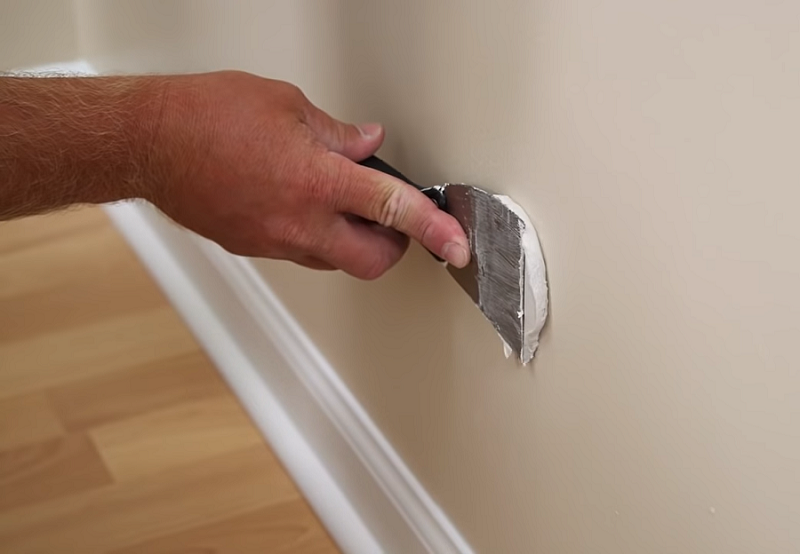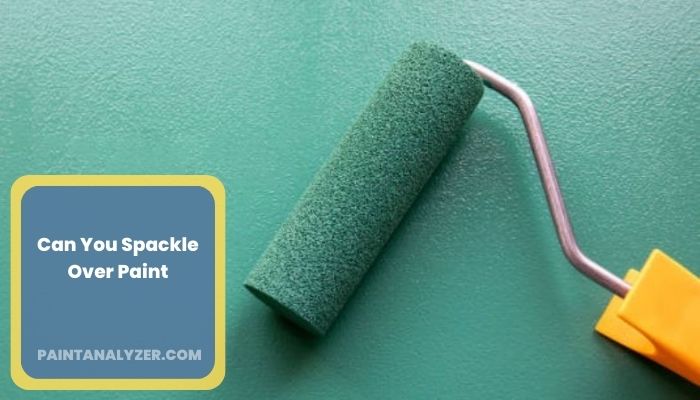Everyone loves to decorate their walls with photo frames, art, and even shelves. But after years, we want to renovate these interiors. Maybe a new color on the wall, or maybe shuffling the mounted artifacts – these are some common parts of our wall renovation.
And to make a new anticipated wall design, you need to patch holes and cracks that occurred due to hanging your past creativities. Spackling over wall paints can solve this issue.
But can you spackle over paint? Well, you can spackle over painted walls. But do you know how to skim or have any idea about why you should try spackling rather than joint compound?
Even if you’re not familiar with any of these, you don’t need to hire an interior expert who’ll cost a fortune.
Instead, let’s do this together, give it a personal touch and make some happy memories. Read this guide to learn everything about how to spackle over wall paints.
Spackle vs. Joint Compound vs. Drywall Mud – What’s the Difference?

They all do the same – setting wall holes or pops in your wall and drywalls. They differ because of their composition and very subtle difference between purposes.
Spackle
The formula comes in both paste and powder forms, a mix of gypsum and binder agents. You can use water while applying it over the wall. A few more traits of spackles are –
- Used for minor wall revamping
- Has a thick consistency
- Comes in small quantity
- Dry fast and leaves low shrinkage results
Drywall Mud/Joint Compound
On the other hand, drywall mud and joint compound are actually the same, with preferable names by home decorators. The components used to make drywall mud are – gypsum, limestone, starch, clay, perlite, and sometimes mica. Usually, it’s –
- Used for patching large cracks and holes on the wall
- Results in high shrinkage after drying
- Tough to smooth the adhesive
- Has a thin consistency
Related: Can You Use Ceiling Paint on Walls?
Different Spackle Types
Depending on the various usage, you will find 5 types of spackle that are used to fix holes and cracks on drywall. These are –
1. Standard Spackle
It’s the most frequently used spackle type. You’ll find it suitable for patching 1-inch holes, and it leaves a hard finish afterward.
2. Lightweight Spackle
Having sodium silicate allows this spackle to dry quite fast. I prefer lightweight spackle if there’s a need for sanding and low shrinkage when it becomes dry. You should try this for typical wall repainting purposes and small dent patching.
3. Vinyl Spackle
If you want to repair deeper wall dents, vinyl is the right choice. The compound is mixed with an elastic polymer, which’s appropriate for deep wall leveling needs.
4. Epoxy Spackle
It comes as a somewhat advanced option; this oil-based spackle is water-resistant. And it lasts longer than previously mentioned solutions. Usually, you get a package of resin and hardener that should be mixed well before application.
5. Acrylic Spackle
You can use acrylic for patching up to ¾-inch thick holes or cracks. Unlike other spackle, this doesn’t shrink after drying. You can use this over drywall, wood, stones, etc.
Will Spackling Stick to Paint?
Yes, spackling sticks to the painted wall. It will help if you use primer on the wall after spackling. The uniform of spackle and primer will hold the paint then.
However, painting over spackled spots means you can still see spackle through paint. As spackled area will absorb colors, that’ll result in an unwanted look afterward.
To solve this problem, use “Quick Drying Spackle” in the process. Also, make two coats of paint after the primer layer.
Related: Can You Paint Over Clear Coat
How To Spackle Over Paint on Old Walls?
Spackling is preferable to reduce efforts in wall painting jobs. But if you don’t follow the right way, it may cause unpleasant results over the wall. Follow this step-by-step guide, therefore.
Step 1: Choose the Right Spackle and Knife
As mentioned above, there’re multiple types of spackle available. First, inspect the holes or crack size and thickness. According to their measurements, pick the spackle type. For example, buy lightweight spackle for smaller wall dents.
For applying spackle over the wall, you’ll need a putty knife. 7th to 10th sized putty knives are usually preferable for interior projects. Pick as you prefer.
Step 2: Make the Wall Ready
As you’re going to mesh this compound over old walls, it’s good to clean it first. Otherwise, the spackle won’t flatten properly.
Sand the wall with sandpaper, dig up all debris from holes with a brush. If they’re the bigger size of holes, it’s wise to use the required amount of cement and paste it into there.
- Tips
If you’ve not bought a spackle that can cover the deeper holes, only then use cement. Otherwise, you can use spackle alone.
And then, use a slightly wet rag or sponge to wipe the wall. Give it a few hours to dry.
Step 3: Mix Spackle
You may have brought either paste or powder spackle. If it’s a paste, there’s nothing to do. Mix a little water if it’s powder kind, and then stir it until it turns into a consistent blend. Do this in a bucket.
Step 4: Spread Over Spackling
Use your putty knife to scoop some spackles. Press the adhesive over and into the dents and damages.
Don’t limit to the holes only. Make an extended layer around the focus area. Do this multiple times unless you see the holes are filled with the compound.
You may see a little portion of the paste seeping out. Leave it that way as you can sand it away later. Then let the wall toppings dry.
Please note that you’ll need to make 2-3 coats of spackle depending on the type of spackle and wall condition. Take a break between every coat to dry it.
When all coats are done, use 120 to 150 grits of sandpaper to mash seeped compounds. Lastly, apply primer throughout the wall and let it dry before applying paints.
- Tip
When applying spackles, keep frequently stirring as they tend to dry fast. Add some water while storing leftover compounds.
Can You Spackle Over Wallpaper?

Spackling over wallpaper is possible, but I won’t recommend it unless you’re biased with any situation. Besides, you should spackle if the wallpaper has been installed recently. Follow the below steps to spackle on wallpaper –
- Make sure to remove all debris dust and flatten all air bubbles before preparing for spackling.
- When this precaution is done, place the textured paper on the wall.
- Set it with wall gum or a very thin layer of spackle. Make sure to level the paper’s seams.
- Do sanding with moderate pressure.
- Then wait for it to dry completely.
- Finally, make another thin coat of spackle over the paper and let it dry.
How Long Should You Break After Spackling Before Painting?
The time of intervals between applying spackle and paints will depend on the type of spackle, your weather or humidity levels, the type of paints vice versa.
For instance, at least take 2 hours before applying paints in case of standard spackle. It just takes 20-30 minutes to dry completely for lightweight spackle.
If it’s a rainy season when you’re applying spackles, keep an interval of 24-48 hours before painting on the wall. Based on the humidity level in the room or already soaked humidity by the wall, the time may vary also.
Do I Have to Primer Over Spackle?
It’s not necessary but vastly advised to use wall primer after applying spackle. The reason is pretty obvious. Primers consist of solvent (up to 70%), synthetic resin (up to 28%), polyethylene, and some additive agents.
The blend helps to deliver a polished finish on the wall after smearing. As a result, you get a better and smoother finishing when applied paint.
Also, it results in a strong unpassable layer so that your wall can’t soak the paints. The combination of primer and spackle also provides strong support to hold the color for long. So, it’s better to use it.
Can I Use Chalk Instead of Spackle?
After applying, chalks or chalky paint leaves a smooth matte finish on the wall, especially on wall corners. On the contrary, spackle mainly works for filling and smoothing cracks or holes. They both are good for the wall. But you can’t use it as an alternative.
Can I Paint Over Spackled Surfaces with Carbon Fiber?
Yes, you can paint over spackled surfaces with the painting carbon fiber technique. This method involves using a special type of paint that mimics the appearance of carbon fiber. It can be applied over spackled surfaces to create a unique and visually appealing finish.
Should You Spackle Over Semi-Gloss Paint?
A big “No.” The ingredients in semi-gloss and glossy paints are not suitable for spackle. Therefore, they don’t stick together.
You may find some people use spackle over semi-glossy paint. And you can as well. But that’ll require you to add more primer than the usual amount after spackling. It’ll increase the cost and won’t last next summer.

Editor’s Verdict
Spackle works like a charm as a filler or repairer of wall holes, and other damages, leaving a smooth polished finish. It can be raw or drywalls or maybe wallpaper. Spackles work on everything.
Applying enough layers of spackle with primer afterward can make your paint last longer than before. Besides, it comes in a low quantity, unlike other joint compounds, making it the budget-friendly wall damage solution for DIY workers.
So, can you put spackle over paint now? I hope you got the answer.
